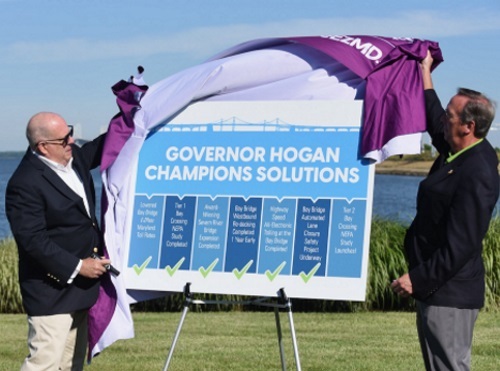At a June 12 event, Governor Larry Hogan (R) said the Maryland Transportation Authority and the Federal Highway Administration are launching a $28 million Tier 2 National Environmental Policy Act study for an additional Chesapeake Bay crossing option.
[Above photo by the Maryland Governor’s Office]
“At my direction, we are immediately launching a critical Bay Crossing Tier 2 Study, which will not only study the new crossing but also look at solutions for the entire 22-mile corridor from the Severn River Bridge to the 50/301 split,” the governor said in a statement.
“This is the critical next step which is needed in order to move forward so we can make a new Chesapeake Bay crossing a reality in the years to come, and it is just one more way that together we are truly changing Maryland for the better,” he added.
He noted that, in April, FHWA approved a combined Final Environmental Impact Statement and a Record of Decision for the proposed bridge, with the Tier 2 NEPA study poised to identify and evaluate a “no-build alternative” as well as various crossing alignments and types – such as a new bridge, a bridge/tunnel or replacement of existing spans.
The study would take about four to five years to complete. If it recommends a “build alignment” alternative, another Record of Decision for Tier 2 would be required before proceeding to final design, right-of-way acquisition, and construction. Meanwhile, a “no-build” recommendation means taking no action of any kind.
The initial Tier 1 study evaluated a range of “modal and operational alternatives” or MOAs, including ferry service, rail, bus, and transportation system management/transportation demand management, and found they could not function as stand-alone options. Subsequently, the Tier 2 study will re-analyze the use of buses, ferries, and transportation system/demand management, especially in conjunction with other mobility alternatives.

